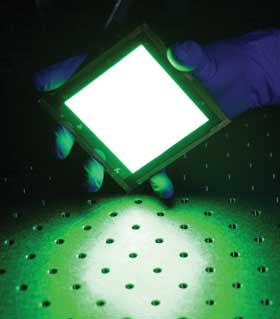Compiled by Photonics Spectra staff
A simple chlorine treatment could improve organic LEDs (OLEDs), speeding
up light display technology manufacturing. The new method also is easier and cheaper
than current techniques.

Prototype of large-area OLEDs fabricated using chlorinated indium tin oxide transparent electrodes.
By engineering a 1-atom-thick sheet of chlorine onto the surface
of an existing industry-standard electrode material – indium tin oxide (ITO)
– found in many flat panel displays, scientists at the University of Toronto
created a medium that provides efficient electrical transport while eliminating
the need for the several costly layers found in traditional OLED devices. They developed
a UV-light-assisted process to achieve the chlorination, negating the need for the
chlorine gas, making the procedure safe and reliable.

A prototype of large-area red, green and blue OLEDs fabricated using chlorinated indium tin oxide transparent electrodes. Images courtesy of the Department of Materials Science
and Engineering, University of Toronto.
The team tested its green-emitting “Cl-OLED” against
a conventional OLED and found that its efficiency was more than double at very high
brightness. Although OLEDs are known for their high efficiency, it tends to drop
off rapidly as brightness increases.
To prevent this drop-off, the team used chlorinated ITO to achieve
a record efficiency of 50 percent at 10,000 cd/m2, at least two times more efficient
than the conventional OLED.

UV treatment process to functionalize the surface of the transparent indium tin oxide electrode with a layer of chlorine 1 atom thick.
The scientists concluded that, by using the Cl-ITO, they could
eliminate the need for several stacked layers found in traditional OLEDs, reducing
the number of manufacturing steps and equipment costs associated with setting up
a production line. They believe that this finding could lower barriers for mass
production, accelerating the adoption of OLED devices into mainstream flat panel
displays and other lighting technologies.
The work was published online April 14, 2011, in Science (doi:
10.1126/science.1202992).